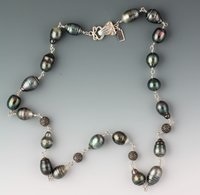Used to be every lady had a nice string of white pearls, but they decreased in popularity after the baby boomers grew up–didn’t really fit in with the hippy/revolutionary image of the sixties I guess….. Pearls have made a resurgence in popularity recently and I am particularly fascinated by big Baroque Tahitian Pearls. These are my “Modern Baroque” Tahitian pearls with 10 ct natural diamonds finished in all Argentium Sterling silver.
What do you need to know abouta pearls to be a savvy shopper? First, realize that there is NO nationally or internationally recognized standard for the grading of pearls. Every vendor has their own system, so use the grades offered to compare with others from that same source. That said, pearls labeled “AAAA” should be of good color, luster and free of blemishes.
Prior to the early part of the 20th century, pearls were “natural” or “wild caught”. A pearl forms when a bit of sand or other irritant (the “nidus”) accidentally enters the clam and the clam starts to secrete nacre around the offending intruder to lessen the irritation. Eventually, after years of secretion, a pearl is formed. Divers would collect hundreds of clams and have to open many to find a single pearl. These days there are virtually no natural or wild caught pearls on the market. Anyone offering pearls labeled as such for less that tens or hundreds of thousands of dollars should be regarded cautiously. However, you might find some vintage or estate pieces with natural pearls on the market and ones with small (“seed”) pearls might be affordable. Pearls today are virtually all cultured. In fact, cultured pearls are so ubiquitous that the term “cultured” has been dropped from the name in most cases. Cultured pearls are either grown in the ocean (salt water or marine) or fresh water. Next week I’ll offer a comparison of fresh and salt water pearls to help you make smart choices.

